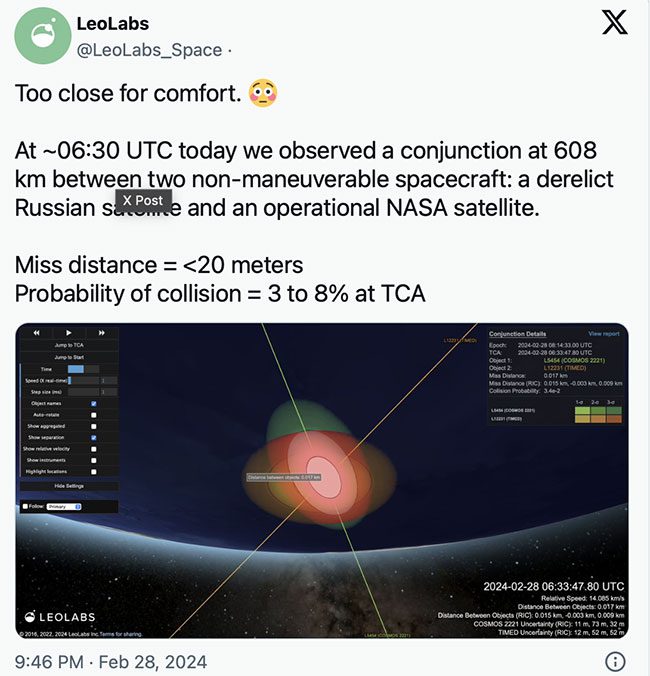The spacecraft from NASA’s Thermosphere, Ionosphere, Mesosphere Energetics and Dynamics (TIMED) mission and the Russian signal intelligence satellite Cosmos-2221 nearly collided while orbiting at an altitude of approximately 378 miles (608 km).
According to the National Aeronautics and Space Administration (NASA), at 1:34 AM EST on February 28 (1:34 PM the same day in Hanoi), the Russian spy satellite Cosmos-2221 (launched in November 1992) passed closely by NASA’s TIMED spacecraft, which has been studying Earth’s atmosphere since 2001.

Data from satellite monitoring company LeoLabs indicates that during the dangerous situation, TIMED and Cosmos-2221 were orbiting at an altitude of about 378 miles (608 km) and were less than 65 feet (20 meters) apart. (Photo: LeoLabs/X).
In a recent update, NASA officials stated that neither TIMED nor Cosmos-2221 could be maneuvered, and they would approach each other again, although this was the closest they have ever come.
NASA’s update did not report the exact distance between TIMED and Cosmos-2221, but data from LeoLabs confirmed that during the incident, they were orbiting at approximately 378 miles (608 km) and were less than 65 feet (20 meters) apart.
According to space.com, such near-miss incidents are becoming increasingly common as Earth’s orbit becomes more congested.
The European Space Agency reports that there are currently about 11,500 satellites orbiting Earth, with only 9,000 of them still operational.
However, this is just the tip of the iceberg, as there are approximately 36,500 pieces of debris measuring at least 4 inches (10 cm) wide, along with over 130 million other fragments with diameters of 1 mm or greater orbiting our planet.
Even small debris can cause severe damage to satellites, considering the speeds at which objects travel in Earth’s orbit. For instance, at an altitude of 250 miles (400 km) or higher—the average height of the International Space Station—objects are moving at speeds of about 17,500 mph (28,160 km/h).


















































